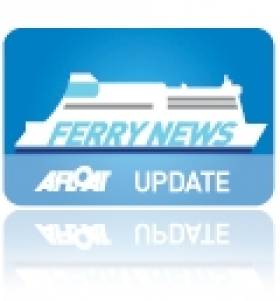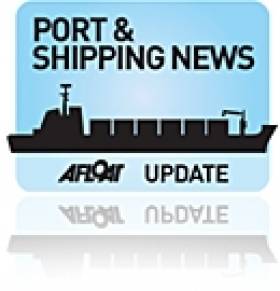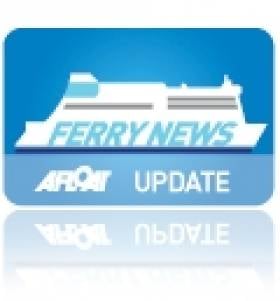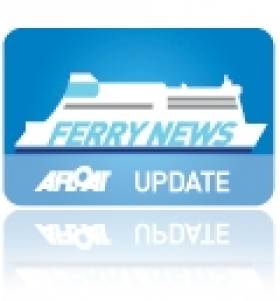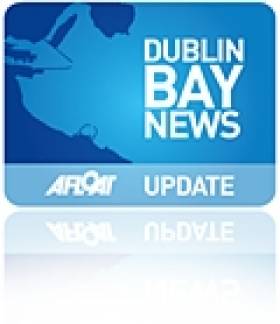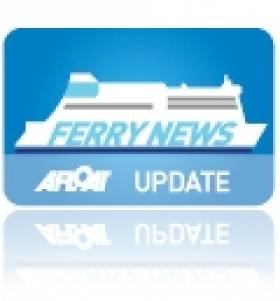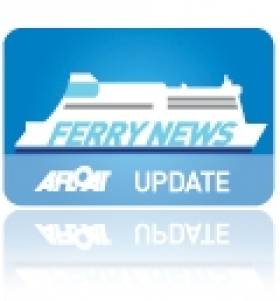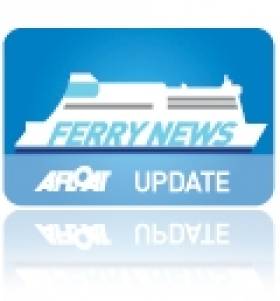Displaying items by tag: Stena Line
HSS Off-Service till Second Year of Seasonal Summer Sailings
#HSS FASTCRAFT – Now that the HSS Stena Explorer has completed her Dun Laoghaire-Holyhead sailings on the day before Little Christmas, it would seem to be part of human nature to only value something when it is lost and only to know how precious it is when it returns, writes Jehan Ashmore.
The HSS had operated albeit briefly "12" days of service over the festive period, in what was somewhat of a surprise move by Stena Line to re-introduce these special sailings, considering that they did not take place during the same season of Winter 2011.
As previously reported on Afloat.ie, in that year, for the first time, the daily operated services on the route closed, breaking a historical link of around 200 years of continuous 'ferry' services. So in the following year, 2012 was marked as the first to operate a seasonal-only service running from Spring to September.
The reduction in sailings could not be so stark since the HSS's introduction in 1996, from the heydays of up to five daily round-trips during peak-season times. A decade later the service began to decline, with reduced frequency and longer passage times.
Despite last weekend's final sailing, the HSS reopens the route for a second year of seasonal-only summer sailings starting 22 March to early September. Once again many will welcome the sight of the HSS looming over the horizon from the Kish Lighthouse and speeding her way across Dublin Bay before entering the harbour mouth.
Ports & Shipping Review: Fate of WWI Warship Secured, Ferry Festive Season, HSS Coincides Celebrating 50th, Mersey Ferry Reduction and Proposed Cross-Border Service
#PORTS & SHIPPING REVIEW - Over the last fortnight of 2012, Jehan Ashmore has reported from the shipping scene where a £1m restoration grant is to be spent on the WWI battlecruiser HMS Caroline.
The festive season saw the return of Stena Line HSS fast-craft Dun Laoghaire-Holyhead sailings which coincided with the Swedish owned ferry giant celebrating 50 years in service.
Across Dublin Bay rivals Irish Ferries added capacity to cope with expected demand by transferring Isle of Inishmore from St. Georges Channel service and onto the Dublin-Holyhead route.
Also running seasonal services to from Dublin Port was the Isle of Man Steam Packet Company whose ro-pax Ben-My-Chree provided two weekend round trips either side of the Christmas festivities.
One of the famous 'ferry cross the Mersey' river ferries linking Liverpool to the Wirral Peninsula is to be withdrawn in January 2013 by operator Mersey Ferries due to reduced traffic and heavy losses.
On a more positive note, albeit on other side of the Irish Sea, there are proposals to start a new cross-border car-ferry service across Carlingford Lough between Greenore, Co. Louth and Greencastle Co. Down.
HSS Sailings Coincide with Ferry Firm’s ‘Festive’ Foundation
#STENA LINE 50TH – The return today of Stena Line's HSS fastcraft festive-season Dun Laoghaire-Holyhead sailings, also marks the 50th anniversary of the Swedish-owned ferry company's maiden voyage 'Christmas Trips' across the Skagerrak, writes Jehan Ashmore.
The contrast could not be so stark between ferry operations of half a century ago and today. The inaugural sailing in 1962 saw the 350 (passenger-only) M/S Østersøen embark with Gothenburgers looking for alcohol, tobacco and food bargains in Skagen at the very northern tip of Denmark.
Present-day vessels on the Gothenburg route albeit to Frederikshavn, are operated by Stena Danica, Stena Jutlandica and HSS Stena Carisma, a smaller version of the revolutionary HSS Stena Explorer.
When the 1,500 passenger capacity catamaran HSS Stena Explorer was introduced on the Dun Laoghaire-Holyhead route in 1996, she was a technological breakthrough, using gas-turbine-powered engines. She also made maritime history as the world´s first (HSS) high-speed sea service ferry put into service and the fastcraft was designed to handle large articulated lorries.
Five decades later the vision and enterprise of founder Sten A. Olsson, remains firmly rooted and as the Stena Line brand which has a route network connecting eight countries, served by more than thirty vessels, and employing 5,700 people, in an area stretching between the Irish Sea and the Baltic.
HSS Fastcraft is Back for Christmas and Beyond
#HSS FASTCRAFT- Stena Line's HSS fastcraft as previously reported on Afloat.ie is to return to the Dun Laoghaire-Holyhead tomorrow, operating the 2hour 15 minute service on 12 selected days during the festive period.
Christmas Sailing Schedule: The fastcraft HSS Stena Explorer will operate sailings on the following dates: 20-23 December, 27-30 December and also early into the New Year between 2-5 January 2013. During these dates the HSS will operate one departure from Dun Laoghaire and Holyhead daily. For HSS sailing schedules and also on the Dublin-Holyhead route, click LINK.
2013 Sailing Schedule: The fastcraft HSS return's to open the 2013 main season on the Dun Laoghaire-Holyhead route starting 22 March. The service will continue through the high-season months and until 10 September.
Stena Line are the only regular commercial company operating out of Dun Laoghaire Harbour and where as previously reported on Afloat.ie the port in 2013, its second season in developing the cruise sector, is to attract 10 cruise callers including Cunard Line's Queen Mary 2 in mid-May.
Ferry-Go-Round in Run-Up to Boost Capacity for Christmas
#FERRY BOOST - Irish Ferries French route cruiseferry Oscar Wilde as previously reported is to undergo its annual dry-dock maintenance next month, however, she is to operate Christmas and New Year sailings between Rosslare-Pembroke Dock, writes Jehan Ashmore.
In mid-October Afloat.ie reported that the Welsh route cruiseferry Isle of Inishmore is to transfer to Dublin-Holyhead route to boost capacity over the busy festive season.
Each of Isle of Inishmore's sailings will provide space for an additional 2,200 passengers and more than 850 cars. She will join the central corridor route's cruiseferry Ulysses and fast-ferry Jonathan Swift otherwise marketed as the Dublin Swift. For sailing schedules including separate panel for sailings served by Isle of Inishmore click this LINK.
Irish Sea rivals Stena Line are to bring back HSS fast-craft Dun Laoghaire-Holyhead sailings for 12 days over the festive and New Year period, for schedule click HERE. In addition Stena also operate year-round Dublin-Holyhead sailings using two conventional ferries marketed as Superferries.
Festive Events Mark Sign of the Times at Dun Laoghaire Ferry Terminal
#TERMINAL CHANGES - Motorists check-in area at the Dun Laoghaire Harbour ferry terminal, is currently a free car-parking facility with donations going to Barnardos, however Stena Line's HSS fast-craft service to Holyhead is to resume next week, albeit only for the festive season, reports Jehan Ashmore.
The Dun Laoghaire Harbour Company in association with Barnardos, has set aside the terminal for free-car parking which is available to next Sunday 16th December. Cars can park Monday to Wednesday (11am - 7pm) and Thursday to Sunday (12noon -8pm). The initiative not only supports a worthy cause but is to encourage customers to shop in Dun Laoghaire in the run-up to Christmas.
As for the HSS Stena Explorer, she reopens the route next Thursday 20th December, though only operating on 12 'selected' days over Christmas and early into the New Year, for sailing dates click HERE.
Also located at the ferry terminal (plaza) will be the Ice Kingdom Slides which opens tomorrow in addition on Marine Road /The Metals is the launch of the Dun Laoghaire Christmas Festival's Chalet Market plus life-size crib featuring 'live' animals outside St. Michael's Church. Also watch out for Firework Displays (on various dates) for details visit: www.dunlaoghaire.ie/christmas-festival/
The reduction in ferry operations in recent years has seen changes with the main ferry terminal entrance as previously reported on Afloat.ie transformed last September into the Shackleton Endurance Exhibition: 'Triumph against all odds'. The exhibition with the support of the harbour's 'masterplan', tells a survival story like no other of the Irish-born explorer Sir Ernest Shackleton and the Imperial Trans-Antarctic expedition of 1914-1917.
On display are more than 150 striking black and white photographs taken by photographer Frank Hurley and an exact replica of the James Caird; the lifeboat that proved so critical to the rescue. The exhibition also sales a range of related merchandise and other nautical-like items in its gift-shop.
Short Sea Shipping Award Goes to Stena Line
#FERRY AWARD – At the annual Irish Exporters Association's Export Industry Awards, among the categories was for the Short Sea Shipping Company of the Year 2012, which was awarded to Stena Line in Rosslare, Co. Wexford.
The award, sponsored by the Irish Maritime Development Office (IMDO), recognises the strategically important role of short sea shipping to our island economy. The other nominees were: Eucon Shipping and Transport Ltd., Dublin and Samskip Multimodal Container Logistics, Dublin.
Stena Line Appoints New CEO
#FERRY NEWS –Stena Line has appointed Carl-Johan Hagman as the new CEO, replacing Gunnar Blomdahl, who has been serving in this role for more than a decade of the Swedish owned ferry giant which celebrates its 50th anniversary this year.
Hagman has since Autumn 2011 been responsible for all shipping operations in the Stena Group, until he takes his new role of CEO on New Year's Day 2013. The 46 year old will continue to hold this position in the Stena Group in the future.
Carl-Johan Hagman commented: "Stena Line is one of the linchpins in Stena AB. The company's strategy remains in place and our continuous efforts to offer comfortable, cost-effective and environmentally efficient ferry transport, to both private travellers and industry, will continue".
"I would like to congratulate Gunnar on successfully leading the company through a sometimes volatile period and thank him for handing over a very well-managed company."
Gunnar Blomdahl took over as Stena Line's CEO in 2003. During the years with Gunnar as CEO, Stena Line has developed into one of the world's largest ferry companies, including the best years historically in terms of profit.
The company has invested around SEK 11 billions in new tonnage and geographic expansion, e.g. through the acquisition of Scandline's five Baltic routes a few months ago.
As a consequence of this change, Carl-Johan Hagman will relinquish the role as Chairman for Stena Line and Dan Sten Olsson (son of Stena Line founder Sten A. Olsson) will once again take on this role.
Stena Line Wins Scottish Passenger Association Award
#FERRY AWARD – Stena Line's first anniversary of the Belfast-Cairnryan route was celebrated with an award for Best Ferry Operator, reports Carrick Today.
The Scottish service is one of five routes the ferry operator runs on the Irish Sea and in which the annual travel excellence award was presented at the Scottish Passenger Agents' Association (SPAA) awards.
Diane Poole OBE, Stena Line's Head of PR and Communications, said she was delighted to see the company receive the title. "It is always a great honour to receive an award but this one is special as it is recognition from our peers in the travel world," she said. "Stena Line would like to thank all at SPAA for their continued work to promote all that is great about our travel industry."
Ferries in Collision at Rosslare Harbour
#FERRY NEWS - A Stena Line ferry was unable to dock in Rosslare last night after a collision with an Irish Ferries passenger craft in heavy winds.
TheJournal.ie reports that the Stena Europe ferry was attempting to dock at Rosslare Harbour after its arrival from Fishguard around 6pm when it made contact with the starboard bow of the Oscar Wilde, which was stationary in port.
RTÉ News says that neither vessel was badly damaged in the incident, but docking was postponed pending the departure of the Irish Ferries vessel, which was expected around 11.30pm last night.
More than 500 passengers and crew were on board the ferry at the time of the incident, which occurred amid gusts of up to 35 knots.
The return journey to Fishguard and this morning's Fishguard-Rosslare sailing were cancelled while an inspection of the vessel gets underway.


























